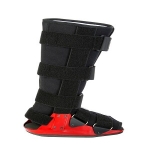
Have to wear a cam walker for the next several weeks to months? It is possible with an ankle fracture, sprain or strain that you may be asked to immobilize the foot and ankle.
There are three ways immobilization might be recommended.
- A short leg cast
- A short leg splint
- Cam walker
The cam walker, also called a cam boot, is a large ski boot, typically blue or black, and may be taken on and off with Velcro straps. There are some versions that are shorter rather than all the way to the top of the calf. There are also ones with an adjustable angle. Your provider will determine what boot is right for you depending on what your injury is. If your provider has placed you in a cam walker, it is important to find out this information.
1. Weight bearing status & Gait Training
Walking with a cam walker can be tricky. It is recommended that you “toe out” (point the toes outward at a 45 degree angle) when walking since the ankle is immobilized and not able to make a fluid motion with each step. Be aware that with this altered gait, you may have soreness in other body areas, such as your low back or knees. Be cognizant of your gait as to not aggravate other areas. Many people find it easier to wear a shoe with a larger lift on the opposite foot, such as a tennis shoe rather than a sandal, to help keep the pelvis more level when walking. Your specific problem with your providers instructions will determine if, when and how much weight you may place on the injured leg. A cam walker is often utilized to progress to full weight bearing. If partial weight bearing, typically you will begin with 1/3 of your weight (find a scale- if you weigh 150, put down your weight on the extremity until the scale hits 50 pounds, this is approximately 1/3 of your weight) . Once your provider has released you and if you are able to progress without pain, you may up the status to ½ weight bearing. Typically, two weeks following this without pain, you may progress to full weight bearing. It is very important that you follow your providers specific instructions on how to progress.
2. Are you able to remove for bathing and/or sleep
This is a common question and you should ask your provider for the specifics. The answer will depend on the severity of the injury, post-operative recovery and if there is wound cleaning necessary.
3. Length of time to wear
It is important to find out how long you will be wearing your boot. Often your boot may start to smell. Quick tip- Always wear your boot with a long sock so you may wash the sock. Disinfectant spray is not recommended.
4. Fitting correctly?
Your technician/nurse will place you in the cam walker the first time and make sure it is fitting properly. You do not want your toes hanging over the end of the boot. Improper fitting could cause tripping or the area to not be immobilized correctly. Please discuss fitting with the person fitting the cam walker and call your providers office if there is a question regarding proper fitting.
5. Insurance coverage?
Lastly, it is important to make sure if your boot will be covered under your health insurance. Is it medically necessary for you to have the boot? Is there authorization that needs to be done before provided to you. Can it be provided by your clinic or do you need to go to another location to have the boot placed. It is possible that your insurance may deny the use of the boot and you may be required to pay out of pocket. In this case, a cast might be a better choice financially if appropriate. The cam walker is a useful tool in recovery of an injury. It may be recommend for many different injuries such as an ankle fracture, Achilles tendon tear, mid-foot injury, foot fractures or significant ankle sprains. It is important to know the above information and if you have questions regarding your specific injury, please discuss them with your provider and/or nurse.
Author: Amy Roberts, MS ATC/L
Kansas City Bone & Joint Clinic
Related Physicians
The providers at Kansas City Bone and Joint Clinic each have their own areas of specialty. Click on the providers below to read more about them.

